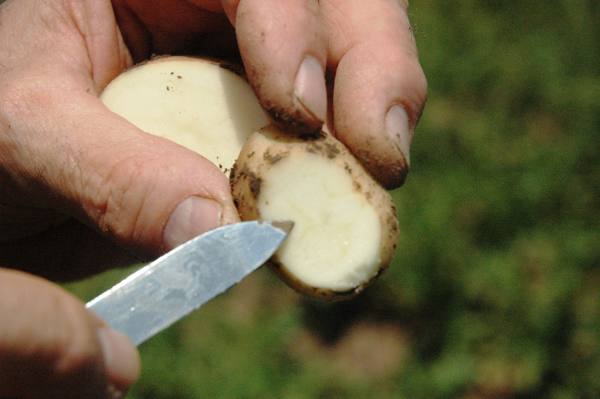October 9, 2012

Researchers and producers will conveneto outline where the potato industry is in the battle against an expensive disease threatening the industry at the Specialty Crop Research Initiative (SCRI)Zebra Chip Annual Reporting Session Oct. 30-Nov. 2 at the Crowne Plaza Hotel Riverwalk, 111 E. Pecan St., San Antonio.
The upcoming zebra chip reporting session allows potato industry representatives and producers to hear the latest research from the multidisciplinary team of scientists on the various aspects of the disease, control and its overall impact on potato production, Rush said.
The conference is the annual meeting of a U.S. Department of Agriculture-National Institute of Food and Agriculture-sponsored Specialty Crop Research Initiative led by Dr. Charlie Rush, Texas A&M AgriLife Research plant pathologist in Amarillo.
Texas potato production is concentrated in the Rio Grande Valley, South Texas, and the southern and northern High Plains. Primarily produced are table stock, seed and chipping potatoes, Rush said. This industry produces about $300 million per year in total business activity and 2,762 jobs in Texas.
The industry was threatened when zebra chip became a major problem for Texas in 2000, he said. It rapidly spread to other regions in the western U.S. and most recently, 2011, was found in the potato-growing regions of Washington, Oregon and Idaho, where more than 50 percent of all U.S. potatoes are grown, primarily for French fries.
Zebra chip disease affects normal development of both the plant and the potatoes, but it is not harmful to humans. In the tubers, the disease causes dark stripes to appear when infected potatoes are sliced and fried to make chips and fries, causing processing plants to reject entire loads of affected potatoes, Rush said. The U.S. averages 20 million tons of potatoes a year, with a farm value of $3.5 billion.
The Texas legislature approved $1.6 million for establishment of a state zebra chip research initiative for 2008-2009. The funds are allocated to the Texas Department of Agriculture and, by agreement, directed by AgriLife Research units for zebra chip research on Texas potatoes, according to Dr. James Supak, program coordinator for the Texas A&M AgriLife Research Zebra Chip Disease Management Program.
This state funding led the way for the national federal initiative, “Management of Zebra Chip to Enhance Profitability and Sustainability of U.S. Potato Production,” which was initially funded at $3.9 million for three years and recently renewed with an additional $2.9 million to continue the research, Rush said.
In recognition of the strides it has made thus far, this multi-state zebra chip research team will receive the Integrated Pest Management Team Award, sponsored by Dow AgroSciences, at the Nov. 12 Entomological Society of America meeting in Knoxville, Tenn.
The state program also has been re-funded, and is supplemented by grower and industry support, which has exceeded $1 million, Supak said.
The state and federal programs complement each other and strive not to overlap, he said.
Supak said the zebra chip disease is caused by a bacterium, Candidatus Liberibacter solanacearum, which is spread by a tiny insect called a potato psyllid.
Controlling the psyllids is a major concern and currently relies heavily on use of insecticides. Researchers and producers are working on and evaluating cultural practices and other strategies to reduce reliance on insecticides to lower costs and minimize the potential for developing psyllid resistance to certain products.
More than 100 researchers and producers are expected to attend the conference, with an estimated 60 percent of the participants expected from outside Texas, demonstrating the national importance of the meeting, Rush said.
During the conference, more than 50 presentations and posters on the latest research will be given in the areas of epidemiology, host-pathogen interaction, pathogen and vector management, pathogen detection, insect biology and monitoring, resistance/germplasm identification, molecular biology and physiology, and the overall impact on potato production.
For more information about zebra chip and the conference, go to http://zebrachipscri.tamu.edu/.
You May Also Like




